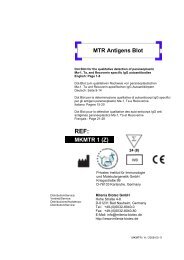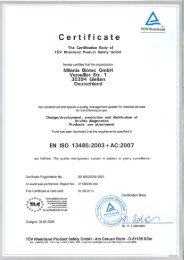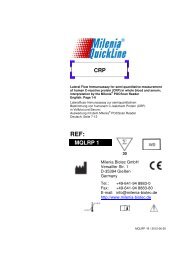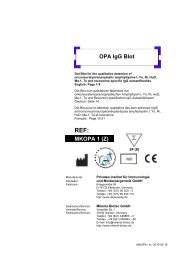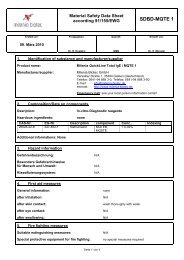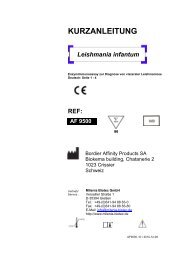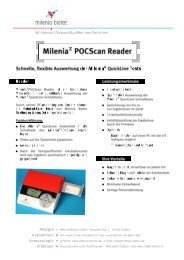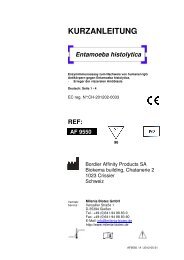Arbeitsanleitung - Milenia Biotec GmbH
Arbeitsanleitung - Milenia Biotec GmbH
Arbeitsanleitung - Milenia Biotec GmbH
Erfolgreiche ePaper selbst erstellen
Machen Sie aus Ihren PDF Publikationen ein blätterbares Flipbook mit unserer einzigartigen Google optimierten e-Paper Software.
HybriDetect 2T<br />
Universal lateral flow dipstick for simultaneous detection of two<br />
different analytes (proteins, genomic amplificates) labelled with<br />
FITC, biotin and digoxigenine; development platform<br />
English: 1-8<br />
Universeller Lateralfluss-Dipstick zum gleichzeitigen Nachweis von zwei<br />
verschiedenen Analyten (Proteine, Gen-Amplifikate) markiert mit FITC,<br />
Biotin und Digoxigenin; Entwicklungsplattform<br />
Deutsch: 9-16<br />
- For research only –<br />
REF:<br />
MGHD2 1<br />
100<br />
<strong>Milenia</strong> <strong>Biotec</strong> <strong>GmbH</strong><br />
Versailler Straße 1<br />
D-35394 Gießen, Germany<br />
Tel.: +49-(0)641-94 88 83 - 0<br />
Fax: +49-(0)641-94 88 83 - 80<br />
E-Mail: info@milenia-biotec.de<br />
http://www.milenia-biotec.de<br />
MGHD2_N / A / 2010-05-19
- 2 -<br />
Explanation of Sym bols<br />
Symbols (GB)<br />
Symbole (DE)<br />
Symboles (FR)<br />
Symboli (IT)<br />
Símbolos (ES)<br />
Jelölés (HU)<br />
Symbole (PL)<br />
Óýìâïëá (GR)<br />
Symbolen (NL)<br />
Explanation<br />
Erklärung<br />
Significato<br />
Significado<br />
Signification<br />
Magyarázat<br />
Objaœnienia<br />
ÅðáîÞãçóç<br />
Verklaring<br />
Symbols (GB)<br />
Symbole (DE)<br />
Symboli (IT)<br />
Símbolos (ES)<br />
Symboles (FR)<br />
Jelölés (HU)<br />
Symbole (PL)<br />
Óýìâïëá (GR)<br />
Symbolen (NL)<br />
Explanation<br />
Erklärung<br />
Significato<br />
Significado<br />
Signification<br />
Magyarázat<br />
Objaœnienia<br />
ÅðáîÞãçóç<br />
Verklaring<br />
Expiry date<br />
Haltbarkeitsdatum<br />
Data di scadenza<br />
Fecha de caducidad<br />
Date d’expiration<br />
Lejárati idõ<br />
Data przydatnoœci<br />
Çìåñïìçíßá ËÞîçò<br />
Uiterste gebruiksdatum<br />
Package size<br />
Packungsgröße<br />
Numero di test<br />
Número de determinaciones<br />
Nombre de tests par trousse<br />
Kiszerelés nagysága<br />
Iloœã testów<br />
ÌÝãåèïò Óõóêåõáóßáò<br />
Verpakkingsgrootte<br />
In Vitro Diagnostic Medical Device<br />
In Vitro Diagnostikum<br />
Dispositivo medico-diagnostico in vitro<br />
Para uso en el Diagnóstico in vitro<br />
Diagnostic in vitro<br />
In vitro diagnosztikum<br />
Do diagnostyki In Vitro<br />
In Vitro éáôñéêÞ äéáãíùóôéêÞ óõóêåõÞ<br />
Medisch hulpmiddel voor in-vitrodiagnostiek<br />
Manufacturer<br />
Hersteller<br />
Produttore<br />
Fabricante<br />
Fabriqué par<br />
Gyártó<br />
Producent<br />
Ðáñáãùãüò<br />
Fabrikant<br />
Batch code<br />
Los-Bezeichnung<br />
Codice del lotto<br />
Lote<br />
Numéro de lot<br />
Sarzsszám<br />
Kod partii towaru<br />
Áñéèìüò Ðáñôßäáò<br />
Partijnummer<br />
Only for evaluation purposes<br />
Nur zur Leistungsbewertung<br />
Solo per uso sperimentale<br />
Con fines exclusivos de evaluación<br />
Pour évaluation uniquement<br />
Kizárólag vizsgálati célokra<br />
Tylko do oceny produktu<br />
Ìüíï ãéá ëüãïõò áîéïëüãçóçò<br />
Uitsluitend ter evaluatie<br />
REF<br />
Catalogue number<br />
Artikel-Nummer<br />
Numero di catalogo<br />
Referencia<br />
Référence<br />
Katalógusszám<br />
Numer katalogowy<br />
Áñéèìüò Êáôáëüãïõ<br />
Catalogusnummer<br />
Consult Instructions for Use<br />
Gebrauchsanweisung beachten<br />
Consultare le istruzioni per l‘uso<br />
Consultar instrucciones de uso<br />
Consulter la notice<br />
A használati utasítás<br />
tanulmányozandó<br />
Informacja dla u¿ytkownika<br />
Óõìâïõëåõôåßôå ôéò ïäçãßåò ÷ñÞóçò<br />
Raadpleeg de gebruiksaanwijzing<br />
Storage conditions Lagerungsbedingungen<br />
Temperatura di conservazione<br />
Temperatura de conservación<br />
Température de conservation<br />
Tárolási körülmények<br />
Temperatura przechowywania<br />
ÓõíèÞêåò Öýëáîçò<br />
Bewaarcondities<br />
Consult attended documents<br />
Begleitdokumente beachten<br />
Consultare i documenti relativi<br />
Consultar documentos adjuntos<br />
Consulter le document avec<br />
attention<br />
A csatolt dokumentumok<br />
tanulmányozandók<br />
Dodatkowe dokumenty<br />
Óõìâïõëåõôåßôå ôá áíôßóôïé÷á Ýíôõðá<br />
Raadpleeg bijgevoegde documenten<br />
<strong>Milenia</strong> <strong>Biotec</strong>, Versailler Straße 1, 35394 Gießen<br />
<strong>Milenia</strong> HybriDetect 2T (MGHD2)
- 3 -<br />
M aterials Supplied, Storage and Stability<br />
Component Cat.-No. Content Preparation Storage Shelf Life<br />
HybriDetect 2T<br />
Dipsticks:<br />
Membrane coated with<br />
biotin-ligand and<br />
polyclonal (goat)<br />
digoxigenine antibody;<br />
polyclonal (rabbit)<br />
anti-FITC antibody in<br />
gold conjugate<br />
MGDS2 2 x 50 tests<br />
(blue<br />
lamination)<br />
Ready-to use 2 –8°C;<br />
Containers must be<br />
always closed<br />
(moisture protection)!<br />
until expiry date<br />
HybriDetect 2T<br />
Assay Buffer:<br />
Tris-buffered saline<br />
MGCB2<br />
2 vials à<br />
10 mL<br />
(yellow cap)<br />
Ready-to use 2 –8°C until expiry date<br />
4<br />
Material Safety Data Sheets are available on request (look as well www.milenia-biotec.de).<br />
M aterials Required<br />
<br />
<br />
<br />
Pipets<br />
Pipet tips (containing protective filters for PCR)<br />
Reaction tubes or 96-well microtiter plate<br />
Necessary Developm ent W ork - Developm ent Platform<br />
Development of two solutions (A and B). Each solution must contain two different labeled detectors for<br />
the respective analyte.<br />
Following conditions are necessary:<br />
1) Solution A: Detectors must be labeled with:<br />
FITC (fluorescein isothiocyanate)<br />
Biotin<br />
2) Solution B: Detectors must be labeled with:<br />
FITC (fluorescein isothiocyanate)<br />
Digoxigenine<br />
3) Use about 100 µL fluid (sample material and analyte-specific solutions, A and B) for the assay procedure.<br />
4) The provided buffers (MGCB2) may be used as a basic for these analyte-specific solutions.<br />
Example of use:<br />
20 µl sample material and 80 µl analyte-specific solutions with 5 min incubation time.<br />
Notice:<br />
Volumes, analyte-specific solutions, and incubation time are part of the individual test development.<br />
A basic procedure for the detection of genomic amplicons is explained on page 7: “Assay performance PCR<br />
products.” One amplification product should be biotinylated and the specific hybridization probe should be FITC<br />
labeled. The second amplification product should be labelled with digoxigenine and the specific hybridization<br />
probe should be FITC labeled.Various amplification procedures (Polymerase Chain Reaction or isothermal<br />
amplifications like LAMP or RPA) can be used.<br />
W arnings and Precautions<br />
All reagents should be stored at 2 – 8° C in their original containers.<br />
Before use, bring all reagents to room temperature (18 – 28° C).<br />
The expiration date of all components must be observed.<br />
Protect dipsticks from humidity; Container must always be closed.<br />
Touch and label only the foil-covered areas of the dipsticks (labeling area).<br />
The assay buffer contains an anti-microbial reagent; therefore avoid contact with skin and/or mucous<br />
membranes.<br />
<strong>Milenia</strong> <strong>Biotec</strong>, Versailler Straße 1, 35394 Gießen<br />
<strong>Milenia</strong> HybriDetect 2T (MGHD2)
- 4 -<br />
M ethod<br />
<strong>Milenia</strong> HybriDetect 2T is a ready-to-use, universal test strip (dipstick), which bases on the lateral flow<br />
technology using gold particles. The dipstick is designed to develop qualitative or quantitative rapid test systems<br />
for simultaneous detection of two different analytes such as proteins, antibodies, or gene amplifications. The<br />
user needs to develop two analyte-specific solutions, with following conditions. Solution A: Contains a first<br />
detector (e.g. antibody, antigen, specific probe) labeled with FITC and a second one (e.g. antibody, primer)<br />
labeled with biotin, and solution B: Contains a first detector (e.g. antibody, antigen, specific probe) labeled with<br />
FITC again and but a second one (e.g. antibody, primer) labeled with digoxigenine, (see “Common<br />
Testprinciple” on page 5).<br />
The sample to be determined is mixed with the developed analyte-specific solutions, and then the dipstick is<br />
placed into this solution.<br />
The complexed analyte (A)-labeled with FITC and biotin, binds first to the gold-labeled FITC-specific antibodies<br />
in the sample application area of the dipstick as well as the complexed analyte B (labeled with FITC and<br />
digoxigenine). The gold complexes A and B diffuse over the membrane by capillarity. Only the analyte captured<br />
gold particles will bound when they overflow the immobilized biotin-ligand molecules at the respective test band<br />
(test band A- analyt A, test band B- analyt B) and generate there a red-blue band over the time. Not-captured<br />
gold particles flow over the control band and will be fixed there by species-specific antibodies. With increasing<br />
incubation time, the formation of an intensely colored control band appears.<br />
Additional available Products<br />
Product Name Order No. Content Description<br />
<strong>Milenia</strong> ® HybriDetect MGHD 1 100 tests Dipsticks with one test band<br />
<strong>Milenia</strong> ® HybriDetect HS MGHT 1 40 tests Test strips with one test band (in a housing)<br />
<strong>Milenia</strong> ® POCScan Reader MSCAN 1 1 device Interpretation device for HybriDetect products<br />
<strong>Milenia</strong> ® HybriDetect<br />
Software<br />
MGSW 1 CD Software for the documentation and/or<br />
quantification of results<br />
<strong>Milenia</strong> ® Carrier MGCA 1 15 pieces Holder for insertion of <strong>Milenia</strong> ® Dipsticks in the<br />
<strong>Milenia</strong> ® POCScan Reader<br />
<strong>Milenia</strong> <strong>Biotec</strong>, Versailler Straße 1, 35394 Gießen<br />
<strong>Milenia</strong> HybriDetect 2T (MGHD2)
- 5 -<br />
Com m on Testprinciple<br />
1) Ready-to-use (analyte-independent) dipstick<br />
Symbols:<br />
FITC<br />
Biotin<br />
Digoxigenine<br />
Sample application place<br />
2) Addition of sample, resp. analyte A and B-specific solutions<br />
Goldparticle<br />
anti-FITC Antibody<br />
Analyte A Detector 1 + 2<br />
Analyte A (Protein, antibody,<br />
genetic amplicon)<br />
Analyte B Detector 1 + 2<br />
Analyte B (Protein, antibody,<br />
genetic amplicon)<br />
Biotin-Ligand<br />
anti-Digoxigenine Antibody<br />
anti-rabbit Antibody<br />
3) Incubation<br />
4) Results: A-positive, B-positive A and B negative<br />
Control Band<br />
Dipstick<br />
Test Band B<br />
Test Band A<br />
A positive, B negative<br />
A negative, B positive<br />
Control Band<br />
Dipstick<br />
Test Band B<br />
Test Band A<br />
<strong>Milenia</strong> <strong>Biotec</strong>, Versailler Straße 1, 35394 Gießen<br />
<strong>Milenia</strong> HybriDetect 2T (MGHD2)
- 6 -<br />
Control Band Dipstick<br />
In any case, the control band must be always visible!<br />
It is a control function and can not be used to assess the test band. If the control band is not visible after the<br />
incubation period, the result is invalid! The test must be repeated with a new dipstick!<br />
Interpretation of Results<br />
There are three possibilities to interpret the <strong>Milenia</strong> ® HybriDetect 2T dipstick results:<br />
1) Qualitative by visual interpretation<br />
e.g.: A, B negative A, B positive<br />
Control Band<br />
Test Band B<br />
Test Band A<br />
2) Semi-quantitative, e.g. by interpretation cards<br />
3) Quantitative interpretation with the <strong>Milenia</strong> ® POCScan Reader and appropiate software<br />
<strong>Milenia</strong> <strong>Biotec</strong>, Versailler Straße 1, 35394 Gießen<br />
<strong>Milenia</strong> HybriDetect 2T (MGHD2)
- 7 -<br />
Assay Perform ance “PCR Products”<br />
1. Take the required number of dipsticks out of the container and<br />
mark them.<br />
2. For each sample to be analyzed pipet 100 µL HybriDetect<br />
Assay Buffer or individual developed buffer into a reaction<br />
tube or a well of a microtiter plate.<br />
3. Pipet 5 – 10 µl of the hybridization product directly on the<br />
sample application area, or<br />
alternatively: add 5 – 10 µl of the hybridization product into<br />
the solution of the reaction tube / well.<br />
4. Place the dipsticks with the sample application area into the<br />
solution and incubate them e. g. for 5 - 15 minutes in an<br />
upright position.<br />
5. In the end of incubation period, remove dipsticks from assay<br />
solution and interpret test results immediately.<br />
Labeling Area<br />
Spot for sample application<br />
Notice:<br />
<br />
<br />
If a higher analytical sensitivity is required, it could be helpful to increase the volume of the PCR<br />
product.<br />
Volumes, analyte-specific solutions, and incubation time are always part of the individual test<br />
development.<br />
Interpretation of “PCR” Results<br />
Applying an internal PCR control:<br />
While the biotin-labeled amplicon A is mainly used for the detection of a specific target sequence the<br />
digoxigenine-labeled amplicon B is provided as an internal PCR amplification control.<br />
Gold<br />
Particle<br />
FITC<br />
Specific probe B<br />
Amplicon B<br />
(Internal PCR<br />
Control)<br />
Digoxigenine<br />
Gold<br />
Particle<br />
FITC<br />
Specific probe A<br />
Amplicon A<br />
Biotin<br />
Dipstick<br />
<strong>Milenia</strong> <strong>Biotec</strong>, Versailler Straße 1, 35394 Gießen<br />
<strong>Milenia</strong> HybriDetect 2T (MGHD2)
- 8 -<br />
Test band A Test band B Control band Interpretation<br />
control band is clearly visible, test run is valid<br />
positive positive positive amplicon A is detected (positive)<br />
internal PCR control is positive (amplicon B)<br />
control band is clearly visible, test run is valid<br />
negative positive positive amplicon A is not detected (negative)<br />
internal PCR control is positive (amplicon B)<br />
positive negative<br />
test runs were not valid because control band<br />
negative positive negative<br />
did not appear<br />
negative negative<br />
negative<br />
rapid test performed properly because control<br />
band is clearly visible<br />
negative pospositive<br />
positive<br />
PCR amplification did not work due<br />
(amplicon B is not detectable )<br />
Trouble Shooting „PCR“<br />
Problem Possible cause(s) Recommendation<br />
Control band is not visible.<br />
a) wrong or destroyed assay buffer<br />
b) expiration date of dipsticks is exceeded<br />
c) wrong storage conditions of dipsticks<br />
apply new (fresh) chemicals<br />
Negative result with dipstick<br />
but clearly visible band in<br />
agarose gel<br />
a) detection of an unspecific PCR product<br />
in agarose gel<br />
b) hybridization was not successful<br />
Check identity of PCR product<br />
by Southern blotting or<br />
sequence analysis<br />
Check conditions of<br />
hybridization.<br />
Mineral oil<br />
a) mineral oil affects flow characteristics<br />
of the assay<br />
b) development of band might be<br />
hampered<br />
Remove PCR product very<br />
slowly from the bottom of the<br />
reaction vial.<br />
Assay Sensitivity “PCR”<br />
Analytical sensitivity of the <strong>Milenia</strong> HybriDetect 2T is equivalent to agarose gel electrophoresis and subsequent<br />
staining with Ethidiumbromide. Independent on the size of the PCR product and the number of amplification<br />
cycles as low as 5 pg DNA could be detected.<br />
Literature-References<br />
Kiatpathomchai W, et al, J Virol Methods (2008); 153: 214-217<br />
Puthawibool T, et al, J Virol Methods (2009); 156 (1-2): 27-31<br />
Jaroenram W, et al, Mol Cell Probes (2009); 23 (2): 65-70<br />
Nimitphak T, et al, Mol Cell Probes (2009); 24 (1): 1-5<br />
Kikuchi T, et al, Nematology (2009) ; 99 (12): 1365-1369<br />
Piepenburg O, et al, PloS Biology 2006, Volume 4, Issue 7, e204<br />
<strong>Milenia</strong> <strong>Biotec</strong>, Versailler Straße 1, 35394 Gießen<br />
<strong>Milenia</strong> HybriDetect 2T (MGHD2)
- 9 -<br />
HybriDetect 2T<br />
Universal lateral flow dipstick for simultaneous detection of two different<br />
analytes (proteins, genomic amplificates) labelled with FITC, biotin and<br />
digoxigenine; development platform<br />
English: 1-8<br />
Universeller Lateralfluss-Dipstick zum gleichzeitigen Nachweis<br />
von zwei verschiedenen Analyten (Proteine, Gen-Amplifikate) markiert<br />
mit FITC, Biotin und Digoxigenin; Entwicklungsplattform<br />
Deutsch: 9-16<br />
- Nur für Forschungszwecke –<br />
REF:<br />
MGHD2 1<br />
100<br />
<strong>Milenia</strong> <strong>Biotec</strong> <strong>GmbH</strong><br />
Versailler Straße 1<br />
D-35394 Gießen, Germany<br />
Tel.: +49-(0)641-94 88 83 - 0<br />
Fax: +49-(0)641-94 88 83 - 80<br />
E-Mail: info@milenia-biotec.de<br />
http://www.milenia-biotec.de<br />
<strong>Milenia</strong> <strong>Biotec</strong>, Versailler Straße 1, 35394 Gießen<br />
<strong>Milenia</strong> HybriDetect 2T (MGHD2)
- 10 -<br />
Erklärung der Sym bole<br />
Symbols (GB)<br />
Symbole (DE)<br />
Symboles (FR)<br />
Symboli (IT)<br />
Símbolos (ES)<br />
Jelölés (HU)<br />
Symbole (PL)<br />
Óýìâïëá (GR)<br />
Symbolen (NL)<br />
Explanation<br />
Erklärung<br />
Significato<br />
Significado<br />
Signification<br />
Magyarázat<br />
Objaœnienia<br />
ÅðáîÞãçóç<br />
Verklaring<br />
Symbols (GB)<br />
Symbole (DE)<br />
Symboli (IT)<br />
Símbolos (ES)<br />
Symboles (FR)<br />
Jelölés (HU)<br />
Symbole (PL)<br />
Óýìâïëá (GR)<br />
Symbolen (NL)<br />
Explanation<br />
Erklärung<br />
Significato<br />
Significado<br />
Signification<br />
Magyarázat<br />
Objaœnienia<br />
ÅðáîÞãçóç<br />
Verklaring<br />
Expiry date<br />
Haltbarkeitsdatum<br />
Data di scadenza<br />
Fecha de caducidad<br />
Date d’expiration<br />
Lejárati idõ<br />
Data przydatnoœci<br />
Çìåñïìçíßá ËÞîçò<br />
Uiterste gebruiksdatum<br />
Package size<br />
Packungsgröße<br />
Numero di test<br />
Número de determinaciones<br />
Nombre de tests par trousse<br />
Kiszerelés nagysága<br />
Iloœã testów<br />
ÌÝãåèïò Óõóêåõáóßáò<br />
Verpakkingsgrootte<br />
In Vitro Diagnostic Medical Device<br />
In Vitro Diagnostikum<br />
Dispositivo medico-diagnostico in vitro<br />
Para uso en el Diagnóstico in vitro<br />
Diagnostic in vitro<br />
In vitro diagnosztikum<br />
Do diagnostyki In Vitro<br />
In Vitro éáôñéêÞ äéáãíùóôéêÞ óõóêåõÞ<br />
Medisch hulpmiddel voor in-vitrodiagnostiek<br />
Manufacturer<br />
Hersteller<br />
Produttore<br />
Fabricante<br />
Fabriqué par<br />
Gyártó<br />
Producent<br />
Ðáñáãùãüò<br />
Fabrikant<br />
Batch code<br />
Los-Bezeichnung<br />
Codice del lotto<br />
Lote<br />
Numéro de lot<br />
Sarzsszám<br />
Kod partii towaru<br />
Áñéèìüò Ðáñôßäáò<br />
Partijnummer<br />
Only for evaluation purposes<br />
Nur zur Leistungsbewertung<br />
Solo per uso sperimentale<br />
Con fines exclusivos de evaluación<br />
Pour évaluation uniquement<br />
Kizárólag vizsgálati célokra<br />
Tylko do oceny produktu<br />
Ìüíï ãéá ëüãïõò áîéïëüãçóçò<br />
Uitsluitend ter evaluatie<br />
REF<br />
Catalogue number<br />
Artikel-Nummer<br />
Numero di catalogo<br />
Referencia<br />
Référence<br />
Katalógusszám<br />
Numer katalogowy<br />
Áñéèìüò Êáôáëüãïõ<br />
Catalogusnummer<br />
Consult Instructions for Use<br />
Gebrauchsanweisung beachten<br />
Consultare le istruzioni per l‘uso<br />
Consultar instrucciones de uso<br />
Consulter la notice<br />
A használati utasítás<br />
tanulmányozandó<br />
Informacja dla u¿ytkownika<br />
Óõìâïõëåõôåßôå ôéò ïäçãßåò ÷ñÞóçò<br />
Raadpleeg de gebruiksaanwijzing<br />
Storage conditions Lagerungsbedingungen<br />
Temperatura di conservazione<br />
Temperatura de conservación<br />
Température de conservation<br />
Tárolási körülmények<br />
Temperatura przechowywania<br />
ÓõíèÞêåò Öýëáîçò<br />
Bewaarcondities<br />
Consult attended documents<br />
Begleitdokumente beachten<br />
Consultare i documenti relativi<br />
Consultar documentos adjuntos<br />
Consulter le document avec<br />
attention<br />
A csatolt dokumentumok<br />
tanulmányozandók<br />
Dodatkowe dokumenty<br />
Óõìâïõëåõôåßôå ôá áíôßóôïé÷á Ýíôõðá<br />
Raadpleeg bijgevoegde documenten<br />
<strong>Milenia</strong> <strong>Biotec</strong>, Versailler Straße 1, 35394 Gießen<br />
<strong>Milenia</strong> HybriDetect 2T (MGHD2)
- 11 -<br />
Kitbestandteile, Lagerung und Stabilität<br />
Komponente Art-Nr. Inhalt Vorbereitung Lagerung Haltbarkeit<br />
HybriDetect 2T<br />
MGDS2 2 x 50 Stück gebrauchsfertig<br />
Vorratsgefäß ver-<br />
Verfallsdatum<br />
2 – 8 °C bis zum<br />
Dipsticks:<br />
(blaue<br />
Membran beschichtet mit<br />
Laminierung)<br />
schlossen halten<br />
Biotin-Liganden und<br />
polyklonalen (Ziege) anti-<br />
(Feuchtigkeitsschutz)!<br />
Digoxigenin-Antikörpern,<br />
polyklonaler (Kaninchen)<br />
anti-FITC-Antikörper im<br />
Goldkonjugat<br />
HybriDetect 2T Laufpuffer<br />
(HybriDect 2T Assay<br />
Buffer):<br />
Tris-gepufferte Salzlösung<br />
MGCB2<br />
2 Fl. à 10 ml<br />
(gelber<br />
Deckel)<br />
gebrauchsfertig<br />
2 – 8 °C bis zum<br />
Verfallsdatum<br />
Sicherheitsdatenblätter sind auf Anfrage erhältlich (siehe auch unter www.milenia-biotec.de).<br />
Erforderliche M aterialien<br />
Pipetten<br />
Pipettenspitzen (mit Kontaminationsschutz für PCR)<br />
Reaktionsgefäße oder eine 96-well Mikrotiterplatte<br />
Nötige Entw icklungsarbeiten - Entw icklungsplattform<br />
Entwicklung zweier Lösungen (A und B), die jeweils zwei verschieden markierte Detektoren für den<br />
gesuchten Analyten enthalten.<br />
Es gelten folgende Rahmenbedingungen:<br />
1) Lösung A: Detektoren müssen markiert werden mit:<br />
FITC (Fluoreszeinisothiocyanat)<br />
Biotin<br />
2) Lösung B: Detektoren müssen markiert werden mit:<br />
FITC (Fluoreszeinisothiocyanat)<br />
Digoxigenin<br />
3) Im Testsystem kann ca. 100 µl Flüssigkeit eingesetzt werden (Probe + Analyt-spezifische Lösungen, A und B).<br />
4) Der im Kit enthaltene Puffer (MGCB2) kann als Basis für diese Analyt-spezifischen Lösungen verwendet<br />
werden.<br />
Anwendungsbeispiel:<br />
20 µl Probe und 80 µl Analyt-spezifische Lösungen bei 5-minütiger Inkubation.<br />
Wichtig:<br />
Volumina, Analyt-spezifische Lösung und Inkubationszeit sind Teil der individuellen Testentwicklung!<br />
Eine Basis-Anleitung für den Nachweis von Gen-Amplifikaten ist unter „Testdurchführung PCR-Produkte“ auf<br />
Seite 15 beschrieben. Hierbei sollte das Amplifikationsprodukt biotinyliert und die spezifische<br />
Hybridisierungssonde mit FITC markiert sein. Im Prinzip können alle Amplifikationsmethoden (Polymerase-<br />
Kettenreaktion oder isothermale Amplifikationen wie LAMP oder RPA) eingesetzt werden.<br />
Hinw eise und Vorsichtsm aßnahm en<br />
Die Lagerung der Reagenzien sollte bei 2 – 8 °C in den Originalverpackungen erfolgen.<br />
Vor der Verwendung sind die erforderlichen Reagenzien auf Raumtemperatur (18 – 28 °C) zu bringen.<br />
Die angegebenen Verfallsdaten aller Komponenten sind zu beachten.<br />
Die Dipsticks sind empfindlich gegenüber Feuchtigkeit; Vorratsgefäß immer verschlossen halten.<br />
Nur die mit Folie bedeckten Bereiche des Dipsticks (Schriftfeld) berühren und beschriften<br />
Die Puffer dieses Testkits enthalten ein Konservierungsmittel zum Schutz gegen mikrobielles Wachstum; daher<br />
ist die Berührung mit der Haut und/ oder Schleimhäuten zu vermeiden.<br />
<strong>Milenia</strong> <strong>Biotec</strong>, Versailler Straße 1, 35394 Gießen<br />
<strong>Milenia</strong> HybriDetect 2T (MGHD2)
- 12 -<br />
M ethodik<br />
<strong>Milenia</strong> HybriDetect 2T ist ein gebrauchsfertiger, universeller Teststreifen (Dipstick), welcher auf der<br />
Lateralfluss-Technologie mittels Goldpartikeln basiert. Der Dipstick kann zur Entwicklung von qualitativen oder<br />
quantitativen Schnelltest-Systemen für den gleichzeitigen Nachweis von zwei verschiedenen Analyten wie<br />
Proteinen, Antikörpern oder Gen-Amplifikaten (z.B. PCR-Produkt und interne PCR-Kontrolle) verwendet<br />
werden. Der Anwender muss dazu zwei Analyt-spezifische Lösungen entwickeln. Es gelten folgende<br />
Rahmenbedingungen:<br />
Lösung A / Analyt A: Ein Detektor (z.B. Antikörper, Antigen, Gensonde) wird FITC markiert, der zweite Detektor<br />
(z.B. Antikörper, Primer) mit Biotin.<br />
Lösung B / Analyt B: Ein Detektor wird FITC markiert, der zweite Detektor mit Digoxigenin (s. „Allgemeines<br />
Testprinzip“ Seite 13).<br />
Die zu untersuchende Probe wird mit den entwickelten Analyt A- und B-spezifischen Pufferlösungen gemischt<br />
und der Dipstick dann in die Lösung gestellt<br />
Der Analyt A-Komplex, markiert mit FITC und Biotin, bindet an die mit Gold-markierten FITC-spezifischen<br />
Antikörper im Probenauftrag des Dipsticks, genauso bindet der Analyt B-Komplex, markiert mit FITC und<br />
Digoxigenin, an die mit Gold-markierten FITC-spezifischen Antikörper. Durch Kapillarkräfte diffundieren die<br />
Gold-Komplexe A und B über die analytische Membran. Bei Überströmen des an der Testbande A<br />
immobilisierten Biotin-Liganden werden nur die mit Analyt-A gekoppelten Goldpartikel gebunden und bilden mit<br />
zunehmender Testzeit eine rot-blaue Testbande A. Bei Überströmen der an der zweiten Testbande B<br />
immobilisierten anti-Digoxigenin-Antikörpern werden nur die mit Analyt-B gekoppelten Goldpartikel gebunden<br />
und bilden mit zunehmender Testzeit eine rot-blaue Testbande B. Nicht abgefangene Goldpartikel überströmen<br />
die Kontrollbande und werden dort durch Spezies-spezifische Antikörper gebunden. Mit zunehmender Testzeit<br />
wird dort die Ausbildung einer intensiv gefärbten Kontrollbande beobachtet.<br />
Zusätzlich verfügbare Produkte<br />
Produktname Bestell-Nr. Inhalt Beschreibung<br />
<strong>Milenia</strong> ® HybriDetect MGHD 1 100 Tests Dipsticks mit einer Testbande<br />
<strong>Milenia</strong> ® HybriDetect HS MGHT 1 40 Tests Teststreifen mit einer Testbande in einem<br />
Plastikgehäuse<br />
<strong>Milenia</strong> ® POCScan Reader MSCAN 1 1 Gerät Auswertegerät für HybriDetect Produkte<br />
<strong>Milenia</strong> ® HybriDetect<br />
Software<br />
MGSW 1 CD Software zur Dokumentation und/oder<br />
Quantifizierung der Ergebnisse<br />
<strong>Milenia</strong> ® Carrier MGCA 1 15 Stück Halterung zum Einlegen von <strong>Milenia</strong> ® Dipsticks<br />
in den <strong>Milenia</strong> ® POCScan Reader<br />
<strong>Milenia</strong> <strong>Biotec</strong>, Versailler Straße 1, 35394 Gießen<br />
<strong>Milenia</strong> HybriDetect 2T (MGHD2)
- 13 -<br />
Allgem eines Testprinzip<br />
1) Gebrauchsfertiger (Analyt-unabhängiger) Dipstick<br />
Symbole:<br />
FITC<br />
Biotin<br />
Digoxigenin<br />
Proben-Auftragsstelle<br />
2) Zugabe von Probe, bzw. Analyt A- und B-spezifischer Lösung<br />
Goldpartikel<br />
anti-FITC Antikörper<br />
Analyt A Detektor 1 + 2<br />
Analyt A (Protein, Antikörper,<br />
Genamplifikate)<br />
Analyt B Detektor 1 + 2<br />
Analyt B (Protein, Antikörper,<br />
Genamplifikate)<br />
Biotin-Ligand<br />
anti-Digoxigenin Antikörper<br />
anti-Kaninchen Antikörper<br />
3) Inkubation<br />
4) Ergebnisse:<br />
A-positiv, B-positiv<br />
A und B negativ<br />
Kontroll-Bande<br />
Dipstick<br />
Testbande B<br />
Testbande A<br />
A positiv, B negativ<br />
A negativ, B positiv<br />
Kontroll-Bande<br />
Dipstick<br />
Testbande B<br />
Testbande A<br />
<strong>Milenia</strong> <strong>Biotec</strong>, Versailler Straße 1, 35394 Gießen<br />
<strong>Milenia</strong> HybriDetect 2T (MGHD2)
- 14 -<br />
Kontroll-Bande Dipstick<br />
Die Kontroll-Bande muss immer sichtbar werden!<br />
Sie dient als Funktionskontrolle und kann nicht zur Beurteilung der Testbande herangezogen werden. Wenn die<br />
Kontroll-Bande nach der Inkubationszeit nicht sichtbar ist, ist das Ergebnis ungültig! Der Test muss mit einem<br />
neuen Dipstick wiederholt werden!<br />
Ausw ertung der Ergebnisse<br />
Es gibt drei verschiedene Möglichkeiten die <strong>Milenia</strong> ® HybriDetect 2T Dipstick-Ergebnisse auszuwerten:<br />
1) Qualitativ : visuelle Auswertung<br />
z.B.: A, B negativ A, B positiv<br />
Kontrol-Bande<br />
Testbande B<br />
Testbande A<br />
2) Semi-quantitativ mit Auswertekarte<br />
3) Quantitative Auswertung mittels <strong>Milenia</strong> ® POCScan Reader und dazugehöriger Software<br />
<strong>Milenia</strong> <strong>Biotec</strong>, Versailler Straße 1, 35394 Gießen<br />
<strong>Milenia</strong> HybriDetect 2T (MGHD2)
- 15 -<br />
Testdurchführung „PCR Produkte“<br />
1. Die erforderliche Anzahl Dipsticks aus dem Röhrchen nehmen<br />
und beschriften.<br />
2. Für jede zu untersuchende Probe 100 µl HybriDetect Puffer<br />
bzw. individuell entwickelten Puffer in einzelne Reaktionsgefäße<br />
oder in die Vertiefungen einer Mikrotiterplatte vorlegen.<br />
3. 5 – 10 µl des Hybridisierungsansatzes direkt auf den<br />
Probenauftrag pipettieren oder<br />
alternativ: 5 – 10 µl des Hybridisierungsansatzes zu der<br />
Lösung im Reaktionsgefäß / in die Vertiefung einer<br />
Mikrotiterplatte pipettieren.<br />
Feld für Beschriftungen<br />
Ort des Probenauftrags<br />
4. Dipsticks mit dem Probenauftrag in die Lösung stellen und z.B.<br />
5 - 15 Minuten aufrecht stehend inkubieren.<br />
5. Nach Ablauf der Testzeit die Dipsticks aus der Lösung nehmen und auswerten.<br />
Hinweise:<br />
Für eine höhere Nachweisempfindlichkeit des Tests kann es hilfreich sein, ein größeres<br />
Volumen des PCR-Produktes einzusetzen.<br />
Volumina, Pufferlösungen und Inkubationszeit sind immer Teil der individuellen Testentwicklung!<br />
Interpretation der „PCR“-Ergebnisse<br />
Verwendung mit interner PCR-Kontrolle:<br />
Während das Biotin-markierte Amplikon A hauptsächlich für den spezifischen Nachweis einer bestimmten<br />
Zielsequenz verwendet wird, ist das Digoxigenin-markierte Amplikon B als interne PCR-Kontrolle vorgesehen.<br />
Gold-<br />
Partikel<br />
FITC<br />
Spez. Sonde B<br />
Amplikon B<br />
(Interne PCR-<br />
Kontrolle)<br />
Digoxigenin<br />
Gold-<br />
Partikel<br />
FITC<br />
Spez. Sonde A<br />
Amplikon A<br />
Biotin<br />
Dipstick<br />
<strong>Milenia</strong> <strong>Biotec</strong>, Versailler Straße 1, 35394 Gießen<br />
<strong>Milenia</strong> HybriDetect 2T (MGHD2)
- 16 -<br />
Testbande A Testbande B Kontrollbande Interpretation<br />
positiv positiv positiv<br />
Kontrollbande ist positiv, gültiger Testlauf<br />
Amplikon A ist nachweisbar (positiv)<br />
interne PCR-Kontrolle (Amplikon B) ist positiv<br />
negativ positiv positiv<br />
Kontrollbande ist positiv, gültiger Testlauf<br />
Amplikon A ist nicht nachweisbar (negativ)<br />
interne PCR-Kontrolle (Amplikon B) ist positiv<br />
positiv<br />
negativ<br />
negativ<br />
negativ<br />
positiv<br />
negativ<br />
positiv<br />
negativ<br />
negativ<br />
negativ<br />
pospositiv<br />
Testläufe sind ungültig, da Kontrollbande nicht<br />
nachweisbar ist<br />
Testläufe wiederholen<br />
Testläufe sind ungültig<br />
Schnelltest ist ordnungsgemäß entwickelt, da<br />
die Kontrollbande positiv is<br />
Amplifikationsreaktionen sind nicht<br />
ordnungsgemäß verlaufen (Amplikon B ist nicht<br />
nachweisbar)<br />
Amplifikationsreaktionen wiederholen<br />
Fehlerquellen und Lösungen „PCR“<br />
Problem Mögliche Ursache Empfehlung<br />
Es ist keine Kontrollbande<br />
sichtbar.<br />
Mit dem Teststreifen wird ein<br />
negatives Ergebnis erhalten,<br />
aber auf einem Agarosegel<br />
ist eine Bande sichtbar.<br />
a) falscher oder nicht mehr funktionsfähiger<br />
Assaypuffer<br />
b) Haltbarkeit der Dipsticks überschritten<br />
c) falsche Lagerung der Dipsticks<br />
a) Die Bande auf dem Gel resultiert von<br />
einem unspezifischen PCR-Produkt<br />
b) Die Hybridisierung war nicht erfolgreich<br />
Neue Chemikalien verwenden<br />
PCR-Produkt auf Identität<br />
überprüfen (z. B. Southern<br />
Blot oder Sequenzierung)<br />
Hybridisierungsbedingungen<br />
überprüfen.<br />
Mineralöl<br />
a) Mineralöl verändert die Fließeigenschaften<br />
des Testsystems.<br />
b) Die Entwicklung der Banden könnte<br />
verlangsamt oder verhindert sein.<br />
PCR-Produkt langsam vom<br />
Boden des Reaktionsgefäßes<br />
pipettieren.<br />
Testsensitivität „PCR“<br />
Die analytische Sensitivität des <strong>Milenia</strong> HybriDetect 2T entspricht derjenigen eines mit Ethidiumbromid<br />
gefärbten Agarosegels. Abhängig von der Größe des PCR-Produktes sowie der Zahl der durchgeführten<br />
Amplifikationszyklen können bis zu 5 pg DNS nachgewiesen werden.<br />
Literatur-Referenzen<br />
Kiatpathomchai W, et al, J Virol Methods (2008); 153: 214-217<br />
Puthawibool T, et al, J Virol Methods (2009); 156 (1-2): 27-31<br />
Jaroenram W, et al, Mol Cell Probes (2009); 23 (2): 65-70<br />
Nimitphak T, et al, Mol Cell Probes (2009); 24 (1): 1-5<br />
Kikuchi T, et al, Nematology (2009) ; 99 (12): 1365-1369<br />
Piepenburg O, et al, PloS Biology 2006, Volume 4, Issue 7, e204




